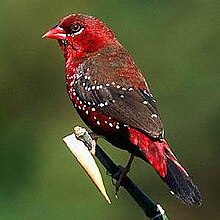Red avadavat
| Red avadavat | |
|---|---|
 |
|
| Male in breeding plumage | |
| Scientific classification | |
| Kingdom: | Animalia |
| Phylum: | Chordata |
| Class: | Aves |
| Order: | Passeriformes |
| Family: | Estrildidae |
| Genus: | Amandava |
| Species: | A. amandava |
| Binomial name | |
|
Amandava amandava (Linnaeus, 1758) |
|
| Synonyms | |
|
|
The red avadavat, red munia or strawberry finch (Amandava amandava) is a sparrow-sized bird of the family Estrildidae. It is found in the open fields and grasslands of tropical Asia and is popular as a cage bird due to the colourful plumage of the males in their breeding season. It breeds in the Indian Subcontinent in the monsoon season. The species name of amandava and the common name of avadavat are derived from the city of Ahmedabad in Gujarat, India, from where these birds were exported into the pet trade in former times.
This small finch is easily identified by the rounded black tail and the bill that is seasonally red. The rump is red and the breeding male is red on most of the upper parts except for a black eye-stripe, lower belly and wings. There are white spots on the red body and wing feathers. The non-breeding male is duller but has the red-rump while the female is duller with less of the white spotting on the feathers.
The red avadavat were earlier included in the genus Estrilda by Jean Delacour. This placement was followed for a while but morphological, behavioural, biochemical and DNA studies now support their separation in the genus Amandava. The Estrildinae are thought to have evolved somewhere in the Indian plate and moving into the African and Pacific regions and it has been estimated that the red munia diverged from the green munia about 9 million years ago.
Red avadavats are found mainly on flat plains, in places with tall grasses or crops, often near water. The species has four named populations. The nominate subspecies is found in Bangladesh, India, Sri Lanka, Nepal and Pakistan; the Burmese form has been called flavidiventris (also found in parts of China, Indonesia, Thailand and Vietnam); the population further east in Java is called punicea and in Cambodia decouxi.
Introduced populations exist in southern Spain,Brunei, Fiji, Egypt,Malaysia, Portugal, Puerto Rico, Singapore and Hawaii.
...
Wikipedia

